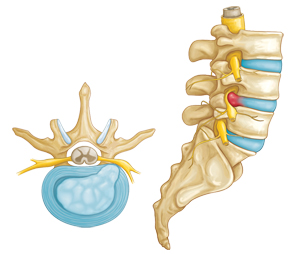Disc Herniation - Introduction
The spine is made up of bones (vertebrae), each one separated by a strong shock absorbing cushion called the intervertebral disc. The role of the disc is to act as an energy converter so as to transmit kinetic energy throughout the torso. This helps in the function of the spine to act as a rigid brace where the spine needs to be a stiff fulcrum but also where the spine needs to act as a coil thus increasing the power of the arms and legs.
There are 7 cervical (neck) vertebrae, 12 thoracic (chest) vertebrae, 5 lumbar (lower back) vertebrae, 5 sacral vertebrae and a coccyx. Disc herniations can appear at the cervical, thoracic and lumbar levels; lumbar and cervical spines are the most frequently affected.
The intervertebral disc is composed of a soft jelly-like material at its centre, surrounded by a very resistant fibrous ring. This jelly is called nucleus pulposus and, when healthy, is generally soft. With ageing, the nucleus begins to dehydrate and becomes dried out. At the same time, there can be cracks in the back part of the fibrous ring through which a jelly fragment can escape.
There are 7 cervical (neck) vertebrae, 12 thoracic (chest) vertebrae, 5 lumbar (lower back) vertebrae, 5 sacral vertebrae and a coccyx. Disc herniations can appear at the cervical, thoracic and lumbar levels; lumbar and cervical spines are the most frequently affected.
The intervertebral disc is composed of a soft jelly-like material at its centre, surrounded by a very resistant fibrous ring. This jelly is called nucleus pulposus and, when healthy, is generally soft. With ageing, the nucleus begins to dehydrate and becomes dried out. At the same time, there can be cracks in the back part of the fibrous ring through which a jelly fragment can escape.
Who gets it and when/what causes this?
Disc degeneration results from the natural ageing of intervertebral discs. It is a 'normal' process.A disc herniation, sometimes referred to as a 'slipped disc' may be caused by:
|

Sedentary occupations seem to be more at risk than jobs involving a lot of physical activity. Smoking, being overweight or obese and lack of fitness, appear to be contributing factors for a disc herniation.
Some studies show that more than 50% of the average population has a non-symptomatic herniated disc. The reasons why a disc herniation becomes symptomatic are not well-known in most cases.
Conservative treatment will often result in improvement of the symptoms of a herniated disc, and the herniation will often reabsorb.
Only a minority of patients (less than 5%) suffering from arm or leg pain due to disc herniation, will possibly need surgical treatment.
The Patient Line website offers information for patients with spinal conditions:
Sciatica, back pain, spinal stenosis, disc herniation, scoliosis and many other spine conditions explained in a clear reliable, and trustworthy way. Not for profit EUROSPINE experts are here to help patients and their families understand what may be worrying them.
EUROSPINE is a society of spine specialists of various disciplines with a large knowledge of spine pathologies. All well-known and accepted treatment modalities for spine pathologies are represented by the members of the society. However, the Society cannot accept any responsibility for the use of the information provided; the user and their health care professionals must retain responsibility for their health care management.

